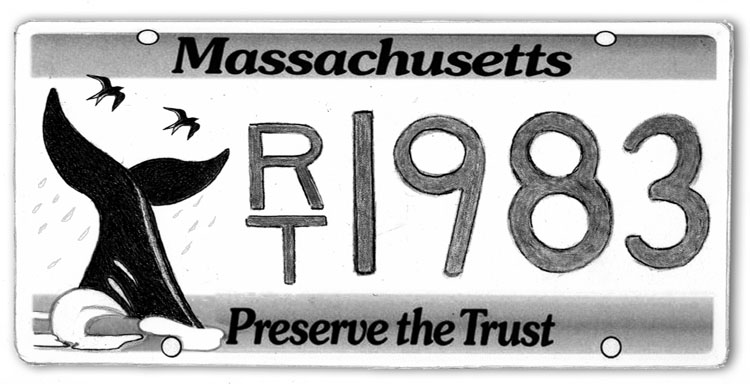
Dear Bird Folks,
Years ago I purchased a specialty, “Preserve the Trust” license plate for my car. The plate depicts a large whale’s tail next to “RW,” in bold letters. I was told RW stands for “Right Whale” and that the money for the plate goes to conservation. Good. My neighbor also has the same plate, but instead of RW, his plate has the letters, “RT.” He told me RT was for a bird, but didn’t know which one. What bird could it be? Ruby-throated hummingbird? Red-tailed Hawk? Any idea?
– Ray, Kingston, MA
You are not alone, Ray,
I frequently see “RT” plates in our parking lot and whenever I ask the driver if she/he knows what RT stands for, they have no idea. Some folks want it to be about whales and think it means “Right Tail” (like that’s somehow a thing). The RT does indeed stand for a bird, and believe it or not, the bird is also on the plate. If you look carefully and squint hard, just above the whale’s tail you’ll see two tiny birds in flight. They are a pair of Roseate Terns, aka, RT. Roseates are beautiful birds, but unfortunately, their image on the plate isn’t very good. (Most plate owners probably mistake them for a couple of squashed bugs.) What’s this you say; you don’t know anything about Roseate Terns? Oh, I can fix that. But first, I want to tell everyone else about Preserve the Trust, and its famous plate.
I think we consider Massachusetts to be a fairly environmentally friendly state. We have a bottle bill, state-supported solar projects and rebates for energy efficient appliances. In fact, one particular website ranks us as the third “greenest” state in the country. Heck, even our “monsters” are green. This was not always the case, however. Back in the roaring 1980s, we “loved that dirty water” too much and were a little careless with the sewage we discharged into Boston Harbor. This led to court battles with the EPA, hefty fines and the usual finger pointing. Eventually, things got sorted out, the water was cleaned up and, among other things, the Massachusetts Environmental Trust was created. This is a good thing.
The Trust is set up to provide grants for environmentally beneficial projects. One of the ways in which the Trust acquires money is through the sale of Preserve the Trust license plates. The cost of these specialty plates is $40.00, with the bulk of the money going to the Trust. While this might not sound like a particularly fast way to acquire money, it actually is. Since its inception, the sale of these plates has generated over twenty-one million dollars for the Trust. There are three different designs to choose from, but most of the public prefers the plate you have…you know, the one that features the tail of a Right Whale and two squashed-bug-looking Roseate Terns.
Most Bay Staters probably don’t know much about Roseate Terns, but the birds love us, or at least they love our coastal islands. Why aren’t we more familiar with them? One of the problems is they typically only come near our shores during the breeding season…and also, they are rare. The entire North American population of these birds consists of a mere 3,200 pairs, with many of those pairs breeding on two tiny islands in our very own Buzzards Bay. The two islands, with a combined area of a scant four acres, are the summer homes to forty percent of North America’s endangered Roseate Terns. This is why the birds are on our license plates.
Like the red belly on the Red-bellied Woodpecker, the pink coloring from which the Roseate Tern earns its name, is difficult to see and is basically only visible during the season. Apparently, the sun ultimately bleaches out the pink. (That’s right, the sun makes them more white and less pink, which is just the opposite of what happens to me when I go to the beach.)
Many birders consider Roseate Terns to be the most beautiful of all the terns and it was this beauty that nearly caused the species’ demise. Early on, many birds were shot for the fashion industry; once we stopped that silliness, hungry gulls became a problem. The yummy garbage found in our dumps artificially increased the gull population. The gulls, in turn, (sorry) fed on baby terns. Today, the terns are protected, but now their breeding islands are threatened. This time the problem isn’t with stupid humans or aggressive gulls, but with nature itself. Erosion (you know, rising seas and all that jazz) is causing their tiny islands to erode. It’s always something.
In late August, after the breeding season, terns of all kinds gather in large flocks in preparation for migration. This is our best chance to see these elegant birds. While the staging areas may vary from year to year, Sandy Neck, Nauset Inlet, Hatches Harbor in Provincetown and Jeremy Point in Wellfleet tend to be reliable locations for tern watching. Check it out, if you don’t mind doing a little (a lot) of walking…and please leave the dog home.
The Preserve the Trust plates are a big hit and have generated much-needed funds for our state’s environment. You should be proud to have the RW on your plate, Ray, while your neighbor should be equally proud to have RT on his plate. Whales are magnificent creatures, but Roseate Terns are also special. Their buoyant flight, pointed wings and long forked tails make them truly beautiful birds. And I can assure you, if you see one, it won’t look anything like a squashed bug.